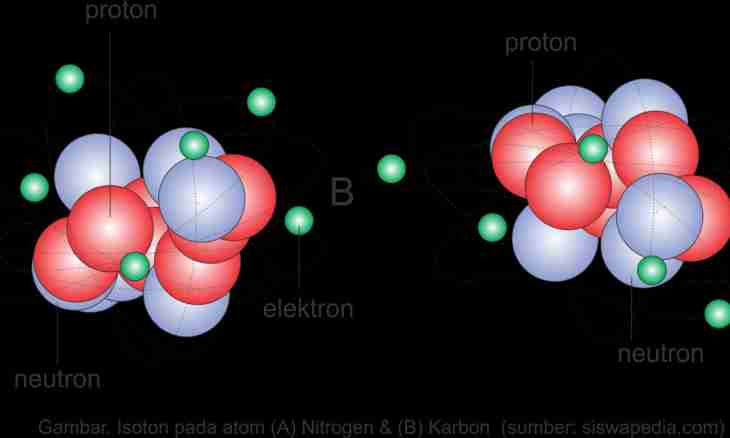The protons and neutrons which are contained in an atomic nucleus are called nucleons. As practically all mass of atom is concentrated in its kernel, the mass number of atom means quantity of nucleons in a kernel. By means of the periodic table of chemical elements of Mendeleyev it is possible to find quantity of protons and neutrons. For this purpose it is also possible to use other techniques.
It is required to you
- — periodic table of chemical elements of Mendeleyev;
- — proton charge;
- — designations of chemical elements.
Instruction
1. To each atom of substance there corresponds the element of the periodic table of Mendeleyev. Find such element for atom, quantity of protons and which neutrons it is necessary to find in a kernel. Determine the atomic mass of this element. It is in the lower part of a cell where chemical element is located. If the mass number is presented by fractional value, round it to whole. This number will be equal to quantity of nucleons in atom. For example, determine the atomic mass of magnesium. Find this element in the periodic table, it has the designation Mg. Its mass number is equal to 24.305. Round it to whole and receive 24. It means that quantity of protons and neutrons (nucleons) in an atomic nucleus of this element equally 24.
2. Define quantity of protons in an atomic nucleus. For this purpose find it in the periodic table of chemical elements. In the top part of a cell of an element its serial number on the account in the table is noted. It is also quantity of protons in an atomic nucleus of the studied element. For example, serial number of magnesium (Mg) is equal to 12. It means that its kernel contains 12 protons.
3. Only the kernel charge in Pendants is sometimes known, then, to find quantity of protons, divide this number into a charge of one proton which is equal 1,6022•10^-19 of the Pendant. For example, if it is known that the charge of a kernel makes 35.2•10^-19 of the Pendant, then having divided it into 1,6022•10^-19 receive the number approximately equal 22. It means that in a kernel of this atom there are 2 protons.
4. After determination of quantity of protons find quantity of neutrons in a kernel. For this purpose from the relative atomic mass of a kernel found by means of the periodic table of chemical elements take away quantity of the protons which are contained in a kernel. As except neutrons of other heavy particles does not contain in an atomic nucleus, it also will be number of neutrons. For example, if it is necessary to find quantity of protons and neutrons in a kernel of phosphorus (P), find it in the periodic table, define mass number and serial number of an element. The mass number of phosphorus is equal 30,97376≈31, and serial number 15. It means that the atomic nucleus of this chemical element contains 15 protons and 31-15=16 neutrons.

